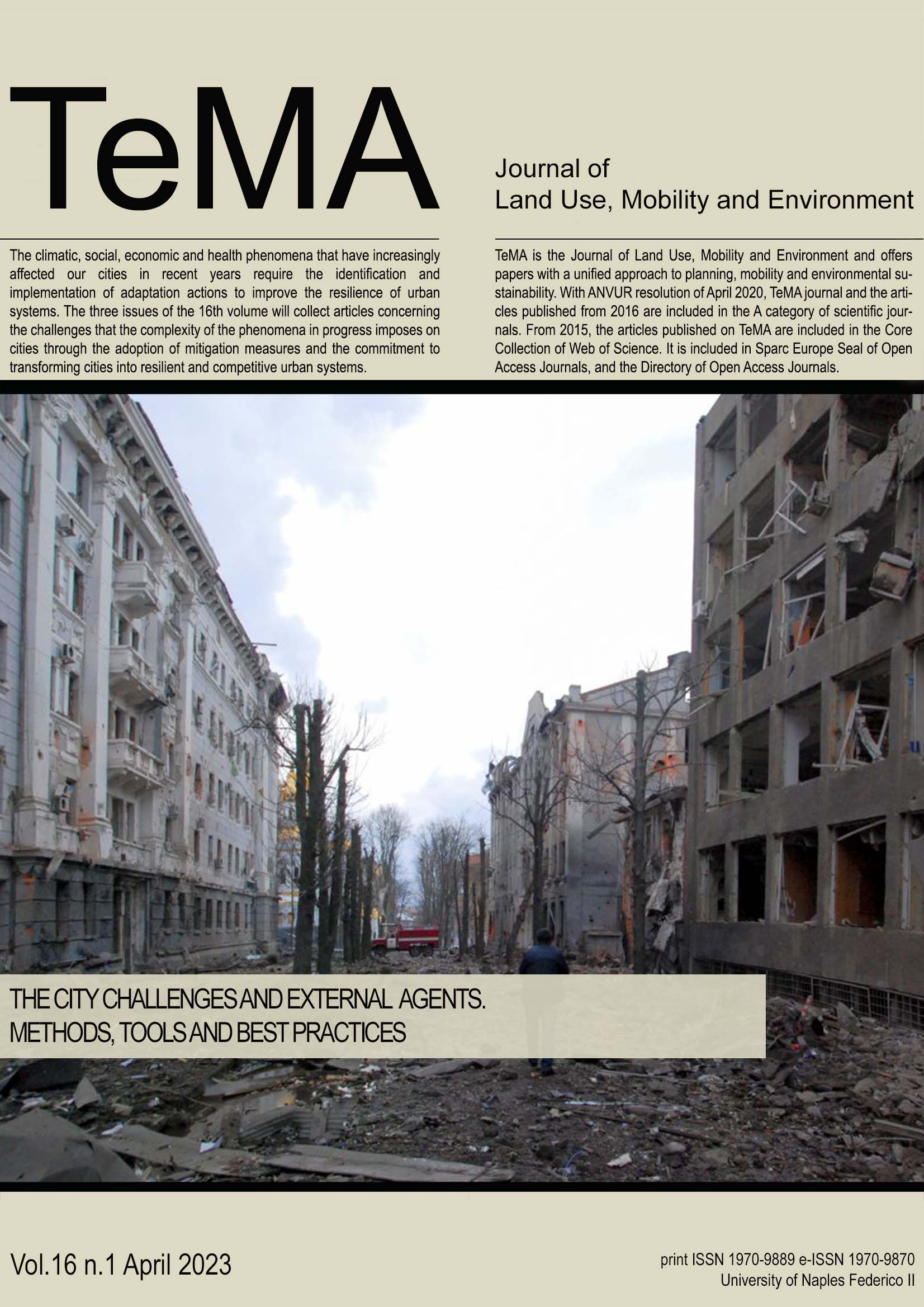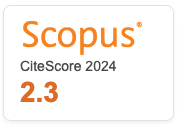Public perceptions of barriers to walk in urban areas of Lahore, Pakistan
DOI:
https://doi.org/10.6093/1970-9870/9353Keywords:
Walking, Pedestrian perceptions, Accessibility, Walking constraints, LahoreAbstract
Development strategies in urban areas of the less developed world are predominantly focused on motorized oriented planning which influenced the mobility practices of individuals. Previous literature has examined the suitability of an integrated public transport system and the potential of cycling in the cities of Pakistan, but walkability received less attention by researchers. To bridge this gap and to enhance the practice of walkability, this study investigates the public perceptions of individuals about walkability constraints in Lahore, Pakistan. A structured based questionnaire survey was conducted by using online platforms. A valid sample of 277 responses were analysed further with weighted factor and regression analysis technique to investigate pedestrian’s perceptions of walkability constraints respectively. Findings indicate pedestrians’ dissatisfaction with existing walking infrastructure is due to ignorance of walkability in transport plans, policies, and strategies executed by the government organizations. The integration of walkability has been highly neglected by transport planners and policymakers. Further, significant walkability constraints are elaborated that need to be resolved to enhance walkability in urban areas for the pedestrians of different age, gender, and income group.
Downloads
References
Abbas, S., Shirazi, S. A., & Qureshi, S. (2018). SWOT analysis for socio-ecological landscape variation as a precursor to the management of the mountainous Kanshi watershed, Salt Range of Pakistan. International Journal of Sustainable Development & World Ecology, 25(4), 351-361.
Ahsan, M. (2019). Making Unaffordable to Affordable: Looking into Affordable Housing Issues and Its Remedies. Architecture and Urban Planning, 15 (1), 22-29. https://doi.org/10.2478/aup-2019-0003
Al-Rashid, M. A., Goh, H. C., Harumain, Y. A. S., Ali, Z., Campisi, T. & Mahmood, T. (2021). Psychosocial barriers of public transport use and social exclusion among older adults: Empirical evidence from Lahore, Pakistan. International journal of environmental research and public health, 18 (1), 185. https://doi.org/10.3390/ijerph18010185
Al-Rashid, M. A., Nadeem, M., Campisi, T., Shamsul Harumain, Y. A., & Goh, H. C. (2022). How Do Psychosocial Barriers Shape Public Transport Use? A Mixed-Method Study among Older Adults in Pakistan. Sustainability, 14 (19), 12471. https://doi.org/10.3390/su141912471
Anwer, I., Masoumi, H., Aslam, A. B., & Asim, M. (2021). Logit and probit models explaining perceived cycling motives, barriers, and biking trip generation in Lahore, Pakistan. TeMA Journal of Land Use, Mobility and Environment, 14 (3), 433-455. https://doi.org/10.6093/1970-9870/8113
Arif, M. M., Ahsan, M., Devisch, O., & Schoonjans, Y. (2022). Integrated Approach to Explore Multidimensional Urban Morphology of Informal Settlements: The Case Studies of Lahore, Pakistan. Sustainability, 14(13), 7788.
Arvidsson, D., Kawakami, N., et al. (2012). Physical activity and concordance between objective and perceived walkability, Med Sci Sports Exerc, 44 (2). https://doi.org/ 10.1249/MSS.0b013e31822a9289
Aslam, S. A. B., Masoumi, H. E., et al. (2018). Cyclability in Lahore, Pakistan: Looking into Potential for Greener Urban Traveling. TeMA Journal of Land Use, Mobility and Environment, 11 (3), 323-343. https://doi.org/10.6092/1970-9870/5806
Aziz, A., Nawaz, M. S., et al. (2018). Examining suitability of the integrated public transport system: A case study of Lahore. Transportation Research Part A: Policy and Practice, 117, 13-25. https://doi.org/10.1016/j.tra.2018.08.003
Bahari, N. I., Arshad, A. K., et al. (2014). Assessing pedestrians’ perspective on the walkability of pedestrian environment under mixed-use development. In InCIEC 2013, pp. 355-367. Springer, Singapore. https://doi.org/10.1007/978-981-4585-02-6_31
Balsas, C. J. L. (2019). Walkable Cities: Revitalization, Vibrancy, and Sustainable Consumption. SUNY Press.
Bharucha, J. (2017). An investigation into the walkability problem in Indian cities. Safer Communities ,16 (2), pp. 77-86. https://doi.org/10.1108/SC-02-2017-0010
Cecchini A., & Talu V. (2011). Walking (and cycling) to change the city. TeMA - Journal of Land Use, Mobility and Environment, 4 (4), 99-108. https://doi.org/10.6092/1970-9870/605
Clark, M. I., Berry, T. R., et al. (2010). Key stakeholder perspectives on the development of walkable neighbourhoods. Health & Place 16 (1), 43-50. https://doi.org/10.1016/j.healthplace.2009.08.001
De Nazelle, A., Bode, O., & Orjuela, J. P. (2017). Comparison of air pollution exposures in active vs. passive travel modes in European cities: A quantitative review. Environment international, 99, 151-160.
https://doi.org/10.1016/j.envint.2016.12.023
Fonseca, F., Ribeiro, P. J., Conticelli, E., Jabbari, M., Papageorgiou, G., Tondelli, S., & Ramos, R. A. (2022). Built environment attributes and their influence on walkability. International Journal of Sustainable Transportation, 16 (7), 660-679. https://doi.org/10.1080/15568318.2021.1914793
Gaglione, F., Gargiulo, C., & Zucaro, F. (2019). Elders’ quality of life. A method to optimize pedestrian accessibility to urban services. TeMA-Journal of Land Use, Mobility and Environment, 12 (3), 295-312. https://doi.org/10.6092/1970-9870/6272
Gargiulo, C., Zucaro, F., & Gaglione, F. (2018). A set of variables for the elderly accessibility in urban areas. TeMA-Journal of Land Use, Mobility and Environment, 53-66. https://doi.org/10.6092/1970-9870/5738
Grant, T. L., Edwards, N., et al. (2010). Neighborhood walkability: older people’s perspectives from four neighborhoods in Ottawa, Canada. Journal of aging and physical activity, 18 (3), 293-312. https://doi.org/10.1123/japa.18.3.293
Gray, J. A., Zimmerman, J. L., et al. (2012). Built environment instruments for walkability, bikeability, and recreation: Disability and universal design relevant?. Disability and health journal, 5 (2), 87-101. https://doi.org/10.1016/j.dhjo.2011.12.002
Hameed, R., & Anjum, G. A. (2016). Improving the Environmental performance of bus-based public Transport system in Lahore-Pakistan. Pakistan Journal of Engineering and Applied Sciences.
Haseeb, A., Saleemi, A., et al. (2018). Spatial analysis for the identification of high-risk locations of road accidents with pedestrian fatalities in lahore. Pakistan Journal of Science, 70 (4), 317. Retrieved from: https://www.proquest.com/scholarly-journals/spatial-analysis-identification-high-risk/docview/2348771590/se-
Ibrahim, M., and Riaz, S. (2018). Lahore growth-Past and future. Retrieved from: http://urbanunit.gov.pk/Upload/Photos/Urban%20Gazette%20Issue%202018.pdf (accessed at 27.04.2020).
Imran, M. & Low, N. (2003). Impact of global institutions on urban transport in Pakistan cities. In Proc. 39th ISoCaRP Congress.
Jabeen, T., Sunbal, M., et al. (2017). Relationship between Women Mobility and Sexual Harassment: Empirical Study of Metropolitan City of Lahore. Pakistan Journal of Criminology, 9 (4), 90. Retrieved from:
JICA. (2012). “The project for Lahore urban transport master plan “in the Islamic republic of Pakistan.” Transport Department, Government of Punjab 2. Retrtieved from: https://www.urbanunit.gov.pk/Upload/Photos/103.pdf (accessed at 30.04.2020).
Jun, H. J., & Hur, M. (2015). The relationship between walkability and neighborhood social environment: The importance of physical and perceived walkability. Applied Geography, 62, 115-124. https://doi.org/10.1016/j.apgeog.2015.04.014
Kelly, C. E., Tight, M. R., et al. (2011). A comparison of three methods for assessing the walkability of the pedestrian environment. Journal of Transport Geography, 19 (6), 1500-1508. https://doi.org/10.1016/j.jtrangeo.2010.08.001
Liao, B., van den Berg, P. E., van Wesemael, P. J., & Arentze, T. A. (2022). Individuals' perception of walkability: Results of a conjoint experiment using videos of virtual environments. Cities, 125, 103650. https://doi.org/10.1016/j.cities.2022.103650
Lo, C. (2010). What are the Main Problems Individuals with Mobility Issues Encounter Daily in the Kingston Galloway Orton Park Neighbourhood?.
Lourenço, J., & Rahaman, K. R. (2010). Pedestrian Planning in City Centers: a Study of Guimarães and Braga. TeMA -Journal of Land Use, Mobility and Environment, 3 (1), 37–46. https://doi.org/10.6092/1970-9870/134
Lockett, D., Willis, A., et al. (2005). Through seniors' eyes: an exploratory qualitative study to identify environmental barriers to and facilitators of walking. Canadian Journal of Nursing Research Archive, 37 (3).
Makki, S., Surat, M., et al. (2012). The importance of design characteristics in walking from student’s perspective: a case study in Universiti Kebangsaan Malaysia. Journal of Building Performance, 3 (1).
Malik, B. Z., Rehman, Z., et al. (2020). Women's mobility via bus rapid transit: Experiential patterns and challenges in Lahore. Journal of Transport & Health, 17, 100834.
Mazzeo, G., Zucaro, F., & Morosini, R. (2019). Green is the colour. Standards, equipment and public spaces as paradigm for the Italian sustainable city. TeMA Journal of Land Use, Mobility and Environment, 12 (1), 31-52. https://doi.org/10.6092/1970-9870/5836
Minhas, M. K., Rehman, Z. U., et al. (2016). A study of factors influencing accidents on Lahore Islamabad motorway (m-2). Pakistan Journal of Science, 68 (1), 63.
Newman, P., and Kenworthy, J. (1999). Sustainability and cities: overcoming automobile dependence. Island press.
Ovstedal, L., and Ryeng, E. (2002). Understanding pedestrian comfort in European cities: How to improve walking conditions. In European Transport Conference, Cambridge, UK (6).
Pak, B. & Verbeke, J. (2013). Walkability as a Performance Indicator for Urban Spaces. Crowdsourcing and Sensing, 1, 423-432. Retrieved from: https://www.researchgate.net/publication/279925396_Walkability_as_a_Performance_Indicator_for_Urban_Spaces_Strategies_and_Tools_for_the_Social_Construction_of_Experiences
Pervaiz, S., Javid, K., Khan, F. Z., Talib, B., Siddiqui, R., Ranjha, M. M., & Akram, M. A. N. (2019). Spatial analysis of vegetation cover in urban green space under new government agenda of clean and green Pakistan to tackle climate change. Journal of Ecological Engineering, 20(4).
Rad, V. B., Najafpour, H., et al. (2014). The Systematic Review on Safety in Urban Neighborhoods. Life Science Journal, 11 (10).
Saelens, B. E., Sallis, J. F., et al. (2003). Environmental correlates of walking and cycling: findings from the transportation, urban design, and planning literatures. Annals of behavioral medicine, 25 (2), 80-91.
https://doi.org/10.1207/s15324796abm2502_03
Shakeel, N., & Jahanzaib, M. (2019). Influence of land use, socio-demographic and travel attributes on travel behaviour in City of Lahore. Architecture and Urban Planning, 15 (1), 67-74. https://doi.org/10.2478/aup-2019-0009
Southworth, M. (2005). Designing the wa. lkable city. Journal of urban planning and development, 131 (4), 246-257. https://doi.org/10.1061/(ASCE)0733-9488(2005)131:4(246)
Strohmeier, F. (2016). Barriers and their influence on the mobility behavior of elder pedestrians in urban areas: challenges and best practice for walkability in the city of Vienna. Transportation research procedia, 14, 1134-1143. https://doi.org/10.1016/j.trpro.2016.05.184
Tahir, M. N., Haworth, N., et al. et al. (2015). Observations of road safety behaviours and practices of motorcycle rickshaw drivers in Lahore, Pakistan. In Proceedings of the 2015 Australasian Road Safety Conference, Australian College of Road Safety (ACRS).
Tariq, F., & Shakeel, N. (2021). Modeling and Predicting Commuters’ Travel Mode Choice in Lahore. Global Social Sciences Reviews VI(III), 106-118. https://doi.org/10.31703/gssr.2021(VI-III).12
Zhang, X. & Mu, L. (2020). Incorporating Online Survey and Social Media Data into a GIS Analysis for Measuring Walkability. In: Lu, Y., Delmelle, E. (eds) Geospatial Technologies for Urban Health. Global Perspectives on Health Geography. Springer, Cham. https://doi.org/10.1007/978-3-030-19573-1_8
Downloads
Published
How to Cite
Issue
Section
License
Copyright (c) 2023 TeMA - Journal of Land Use, Mobility and Environment

This work is licensed under a Creative Commons Attribution 4.0 International License.
Authors who publish in this journal agree to the following:
1. Authors retain the rights to their work and give in to the journal the right of first publication of the work simultaneously licensed under a Creative Commons License - Attribution that allows others to share the work indicating the authorship and the initial publication in this journal.
2. Authors can adhere to other agreements of non-exclusive license for the distribution of the published version of the work (ex. To deposit it in an institutional repository or to publish it in a monography), provided to indicate that the document was first published in this journal.
3. Authors can distribute their work online (ex. In institutional repositories or in their website) prior to and during the submission process, as it can lead to productive exchanges and it can increase the quotations of the published work (See The Effect of Open Access)



